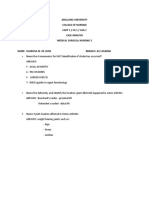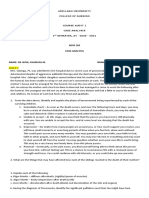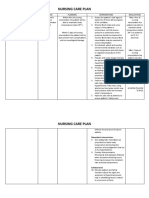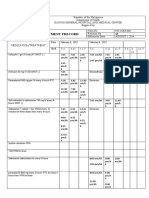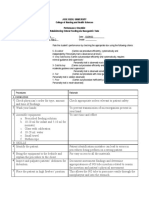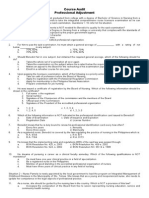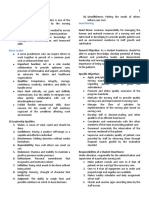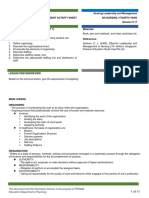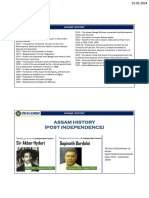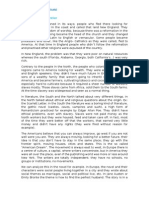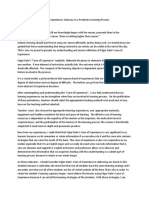100%(1)100% found this document useful (1 vote)
407 views1 pageAcute Renal Failure
1) Judy Devak was in a serious car accident and suffered multiple injuries including a fractured femur. She developed acute renal failure, likely due to hypotension from blood loss.
2) She was admitted to the ICU with oliguria. Tests showed renal dysfunction and she was diagnosed with acute renal failure. Medications were prescribed to protect her stomach and reduce acid.
3) Her urine output gradually increased over several days. Her kidney function and lab results improved, though she remained at risk for infection. She was discharged after her renal function nearly returned to normal.
Uploaded by
Sonia Letran SingsonCopyright
© Attribution Non-Commercial (BY-NC)
Available Formats
Download as PDF, TXT or read online on Scribd
Download as pdf or txt
100%(1)100% found this document useful (1 vote)
407 views1 pageAcute Renal Failure
1) Judy Devak was in a serious car accident and suffered multiple injuries including a fractured femur. She developed acute renal failure, likely due to hypotension from blood loss.
2) She was admitted to the ICU with oliguria. Tests showed renal dysfunction and she was diagnosed with acute renal failure. Medications were prescribed to protect her stomach and reduce acid.
3) Her urine output gradually increased over several days. Her kidney function and lab results improved, though she remained at risk for infection. She was discharged after her renal function nearly returned to normal.
Uploaded by
Sonia Letran SingsonCopyright
© Attribution Non-Commercial (BY-NC)
Available Formats
Download as PDF, TXT or read online on Scribd
Download as pdf or txt
Download as pdf or txt
You are on page 1/ 1
774 UNIT VII / Responses to Altered Urinary Elimination
Nursing Care Plan
A Client with Acute Renal Failure
Judy Devak is driving home late one evening • Maintain skin integrity.
when she loses control of her car trying to avoid • Use the trapeze appropriately to adjust position in bed while
hitting a deer in the road.Her car strikes a tree and rolls into a deep maintaining body alignment.
ditch beside the road, out of sight of passing cars.The wreek is not • Remain free of infection, bleeding, or respiratory distress.
discovered until 2 hours later. On arrival at the accident scene, the
paramedics find Ms. Devak hypotensive: BP 90/60, P 120, and R 24. PLANNING AND IMPLEMENTATION
She is alert and in severe pain, with a fractured right femur. After The following nursing interventions are planned and imple-
immobilizing Ms. Devak’s neck and back and extricating her from mented in the intensive care unit.
the car, they apply a traction splint to her leg and transport her to • Maintain patient-controlled analgesia.
the local hospital. • Assess frequently for pain control and response to analgesia.
• Encourage expression of thoughts, feelings, and fears about
ASSESSMENT condition and placement in ICU.
Katie Leaper, RN, obtains a nursing history on Ms. Devak’s admis- • Document vital signs and heart and lung sounds at least every
sion to the intensive care unit. Ms. Devak indicates that she has 4 hours.
been healthy, having experienced only minor illnesses and chick- • Weigh every 12 hours.
enpox as a child.She has never been hospitalized,and knows of no • Document hourly intake and output.
allergies to medications. Ms. Devak is not currently taking pre- • Restrict fluids as ordered, including diluent for all intravenous
scription or nonprescription drugs. Physical assessment findings medications as intake.
include T 97.4° F (36.3° C) PO, P 100, R 18, and BP 124/68. Skin pale, • Assist with mouth care every 3 to 4 hours; allow frequent rins-
cool, and dry, with multiple scrapes, minor abrasions, and bruises ing of mouth and ice chips as allowed.
on face and extremities. A linear bruise is noted on her chest and • Assist with position changes at least every 2 hours; teach use of
abdomen from the seat belt. Lung sounds clear, heart tones nor- the overhead trapeze.
mal, and abdomen tender but soft to palpation. Right leg align- • Monitor frequently for signs of infection, bleeding, or respira-
ment maintained with skeletal traction. One unit of whole blood tory distress.
was infused prior to ICU admission, a second unit is currently in-
fusing. An indwelling urinary catheter and a nasogastric tube are EVALUATION
in place. After just over 3 days of oliguria, Ms. Devak’s urine output in-
During the first few hours after admission, Ms. Leaper notes creases. By the end of the fourth day she is excreting 60 to 80
that Ms. Devak’s hourly output has dropped from 55 mL to 45 mL mL/hour of urine. Although her BUN, serum creatinine, and potas-
to 28 mL of clear yellow urine. The physician orders a 500 mL in- sium levels remain high, they never reach a critical point, and dial-
travenous fluid challenge, STAT urinalysis, BUN, and serum creati- ysis is not required.She is transferred from the ICU on the fifth day
nine. The fluid challenge elicits only a slight increase in urine out- after admission. When Ms. Devak is able to begin eating, she is
put. Urinalysis results show a specific gravity of 1.010 and the placed on a low-potassium diet, restricted to 50 g of protein. Her
presence of WBCs, red and white cell casts, and tubular epithelial renal function gradually improves. By discharge, results of her re-
cells in the sediment. Ms. Devak’s BUN is 28 mg/dL; her serum cre- nal function studies, including BUN and serum creatinine, are
atinine, 1.5 mg/dL. The physician diagnoses probable acute renal nearly normal. Ms. Devak verbalizes an understanding of the
failure and orders a nephrology consultation. In addition, the need to avoid nephrotoxins such as NSAIDs until allowed by her
physician orders aluminum hydroxide,10 mL every 2 hours per na- physician.
sogastric tube, and ranitidine 50 mg intravenously every 8 hours. Critical Thinking in the Nursing Process
DIAGNOSIS 1. What was the most likely specific precipitating factor for Ms.
Ms. Leaper identifies the following nursing diagnoses: Devak’s acute renal failure? Did anything else contribute to
Acute pain related to injuries sustained in accident her risk?
Anxiety related to being in the intensive care unit 2. Why did the physician prescribe aluminum hydroxide and
Risk for excess fluid volume related to impaired renal function ranitidine? Consider both the acute renal failure and Ms.
Impaired physical mobility related to skeletal traction Devak’s placement in the intensive care unit.
Altered protection related to injuries and invasive procedures 3. Ms. Devak is at risk for respiratory distress related to potential
fluid volume excess. How does her fractured femur further
EXPECTED OUTCOMES contribute to risk for respiratory distress?
The expected outcomes for the plan of care are that Ms.Devak will: 4. Develop a care plan for Ms. Devak for the nursing diagnosis,
• Report adequate pain control. Diversional activity deficit.
• Verbalize reduced anxiety.
• Maintain stable weight and vital signs within normal range. See Evaluating Your Response in Appendix C.
You might also like
- Acute Renal Failure Comprehensive Case AnalysisNo ratings yetAcute Renal Failure Comprehensive Case Analysis7 pages
- Grand Coaching: Medical Surgical NursingNo ratings yetGrand Coaching: Medical Surgical Nursing22 pages
- NCP Hyperthermia Related To Underlying InfectionNo ratings yetNCP Hyperthermia Related To Underlying Infection2 pages
- Cmpa411 Prelim (TFN, Funda, Maternal 217, CHN)No ratings yetCmpa411 Prelim (TFN, Funda, Maternal 217, CHN)460 pages
- Nursing Care of Clients With Multisystem ProblemsNo ratings yetNursing Care of Clients With Multisystem Problems126 pages
- Altered Urinary Elimination - ADPCN Resource UnitNo ratings yetAltered Urinary Elimination - ADPCN Resource Unit5 pages
- The Nursing Diagnosis Body Image Disturbance Is Most Likely To Be Written For Which of The Following PersonsNo ratings yetThe Nursing Diagnosis Body Image Disturbance Is Most Likely To Be Written For Which of The Following Persons3 pages
- Experiences of Operating Room Nurses in Promoting Quality Perioperative Patient CareNo ratings yetExperiences of Operating Room Nurses in Promoting Quality Perioperative Patient Care7 pages
- Care of Clients With Life Threatening Conditions, Acutely Ill/Multi-Organ Problems, High Acuity, and Emergency SituationNo ratings yetCare of Clients With Life Threatening Conditions, Acutely Ill/Multi-Organ Problems, High Acuity, and Emergency Situation75 pages
- PNLE - FON Practice Exam For Oxygenation and Nutrition RNpedia100% (1)PNLE - FON Practice Exam For Oxygenation and Nutrition RNpedia23 pages
- Nursing Association of The Philippines - OARGA100% (1)Nursing Association of The Philippines - OARGA56 pages
- Blood Pressure Measurement Is An Important Part of The Patient's Data Base. It Is Considered To BeNo ratings yetBlood Pressure Measurement Is An Important Part of The Patient's Data Base. It Is Considered To Be1 page
- Kardex: Date/ Time Medications Date Treatment/ ManagementNo ratings yetKardex: Date/ Time Medications Date Treatment/ Management2 pages
- College of Nursing Allied Health SciencesNo ratings yetCollege of Nursing Allied Health Sciences38 pages
- Advisory No. 12 (CV-CHD Vaccination Operation Center) : Cagayan Valley Center For Health DevelopmentNo ratings yetAdvisory No. 12 (CV-CHD Vaccination Operation Center) : Cagayan Valley Center For Health Development7 pages
- Fundamentals of Nursing: Jessie Daclis, RN, Usrn, MbacNo ratings yetFundamentals of Nursing: Jessie Daclis, RN, Usrn, Mbac110 pages
- NCM 117 Week 4 Personality Theories and Determinants of Psychopathology Part 1 (20230218211700) PDFNo ratings yetNCM 117 Week 4 Personality Theories and Determinants of Psychopathology Part 1 (20230218211700) PDF50 pages
- Medical-Surgical Nursing Exam 20: NLE Style (100 Items) : Answers & RationaleNo ratings yetMedical-Surgical Nursing Exam 20: NLE Style (100 Items) : Answers & Rationale15 pages
- Ventricular Septal Defect, A Simple Guide To The Condition, Treatment And Related ConditionsFrom EverandVentricular Septal Defect, A Simple Guide To The Condition, Treatment And Related ConditionsNo ratings yet
- The Ride of Your Life: What I Learned about God, Love, and Adventure by Teaching My Son to Ride a BikeFrom EverandThe Ride of Your Life: What I Learned about God, Love, and Adventure by Teaching My Son to Ride a BikeNo ratings yet
- Harcus Lobo, Residing at 23-53, ... Vs Harold J. Dcosta, Residing at ... On 27 February, 2002 PDFNo ratings yetHarcus Lobo, Residing at 23-53, ... Vs Harold J. Dcosta, Residing at ... On 27 February, 2002 PDF4 pages
- Sir Akbar Hydari Gopinath Bordoloi: Assam History (Post Independence) Assam History (Post Independence)No ratings yetSir Akbar Hydari Gopinath Bordoloi: Assam History (Post Independence) Assam History (Post Independence)6 pages
- Explaining The Do-It-Yourself (DIY) Retail Market in A Developing Country: Preliminary Lessons From IndiaNo ratings yetExplaining The Do-It-Yourself (DIY) Retail Market in A Developing Country: Preliminary Lessons From India19 pages
- CHAPTER 4 Part 1 Risks and Rates of ReturnNo ratings yetCHAPTER 4 Part 1 Risks and Rates of Return9 pages
- STPM Biology Semester 2 Revision ExercisNo ratings yetSTPM Biology Semester 2 Revision Exercis39 pages
- Mustang Skid Steer Loader 1900r 2200r 2600rr190 r220 r260 Service Manual 50950134No ratings yetMustang Skid Steer Loader 1900r 2200r 2600rr190 r220 r260 Service Manual 5095013417 pages
- Production Management - PRDH20-2: Session 11 Theory of Constraints (TOC)No ratings yetProduction Management - PRDH20-2: Session 11 Theory of Constraints (TOC)20 pages
- Musical Times Publications Ltd. The Musical Times100% (1)Musical Times Publications Ltd. The Musical Times9 pages
- Calculus I: Lecturer: Eng Fuaad Abdirizak ElmiNo ratings yetCalculus I: Lecturer: Eng Fuaad Abdirizak Elmi17 pages



